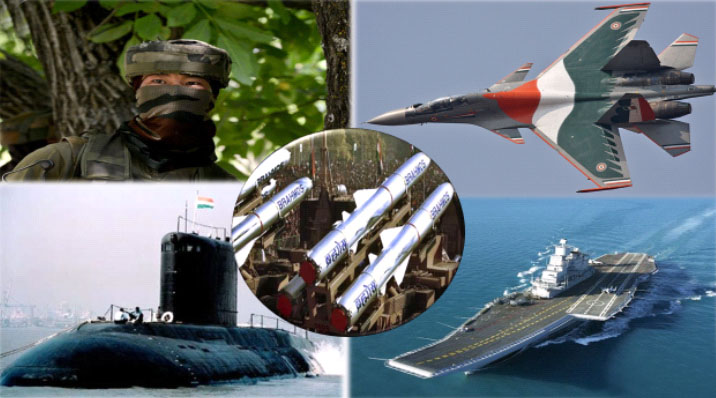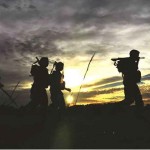The military, which is a major component of the nation’s CNP, needs to be contribute meaningfully to this future, for which it needs to be given direction and enabled in terms of capabilities. Evolving a Military Doctrine to channelize its growth and provide direction is, therefore, the need of the hour. This is a national requirement that merits intervention at the highest political levels to prevent turf battles which have proved to be the biggest impediment thus far. At the same time, it is reiterated that providing a Military Doctrine is not the requirement of the military but of the civil leadership and it is they who need to recognise the necessity to change and having done so, provide the necessary direction and impetus. Left to themselves, neither the bureaucracy nor the services or for that matter the Para Military Forces would solicit for change – they would be content with the status quo ensconced in the comfort of their respective empires.
“War throughout the ages has been a battle of doctrines. The really decisive successes have come from those who adopted a new doctrinal concept to which their enemies were unable to respond.” — John A Warden III, US Air Force
Lying at the heart of Military Activity and braiding the three levels of warfare, ‘doctrine’ defines the path, objectives and pace of development of the defence forces. While a ‘doctrine’ is defined as a body or system of teaching relating to a particular subject, the US definition of ‘Military Doctrine’ which is universally acceptable defines this as, “laying fundamental principles by which Military Forces guide their actions in support of National Objectives.” Since Military Doctrine is crucial to provide direction, it is axiomatic that its absence can result in defence planning to be out of sync with foreign policy aspirations and/or result in the disjointed growth of security forces; both evident in the case of India.
It is also pertinent to highlight that in the absence of a doctrine emphasising synergy in force application, Independent India has created more impediments ‘within’ the system than it has made enemies outside its borders – weak decision making, indifferent structures, impermeable civil-military relations and lack of ‘jointmanship’ amongst the Services, heading the list. Having stated what is well known, there is a need for course correction to put our house in order to ensure that our security planning supports the ends of the India’s current and futuristic foreign policy.
Military power is not merely a component of the nation’s Comprehensive National Power (CNP), it is an indispensable tool for diplomacy…
The demi-official study ‘Non Alignment 2.0’ has (rightly) observed that ‘India stands at a pivotal moment in its history….the main thing that can hold back India is India itself.”1 The study also provides guidelines and policy options, based on which the proposed Military Doctrine can be derived. Having said that, the doctrine needs to be articulated in the form of a blueprint defining the objectives, desired capabilities and inter se priorities. This is a major challenge, at the same time, it is a requirement whose time has (finally) come; an imperative that merits the attention of India’s leadership.
In one of his most profound articulations on the state of the People’s Liberation Army (PLA), in 1975, Deng Xiaoping set the tone for undertaking large-scale military reforms in China – a transformation which in two decades has changed the security landscape of the world. He pinpointed five traits of the then PLA which he said were ‘bloated, lax, arrogant, extravagant and slothful.’ If ‘arrogance’ was to be substituted with ‘deferential,’ and ‘slothful’ for being ‘busy without business,’ he could well be passing judgement over the state of the Indian defence forces. This is the uncomfortable reality of the Indian defence forces, a reality that would be denied in public reflexively by the brass, but would resonate with the majority, especially with the middle and lower rungs of military leaders. This makes it yet another reason to act before its hollowness is put to test – the earlier the process starts, the better.
Military power is not merely a component of the nation’s Comprehensive National Power (CNP), it is an indispensable tool for diplomacy. Ipso facto, more than the uniformed leadership, it is India’s civilian security planners who are required to take the initiative to take a de novo look at India’s strategic requirements and set the tone by extrapolating the contours around which a holistic Military Doctrine could be developed in tune with the challenges. Substantiating the point that Military Doctrines need to be sensitive to the threat dynamics, examples that merit attention are given in succeeding paragraphs.
Military Doctrines – The Revolution in Military Thought
Within a span of sixty years after the Great War, the war that was fought to end all wars, an undeclared war in the form of the Cold War erupted between the former allies even before the fires of the World War had been put out. While this period of internecine fighting saw no physical combat, it saw the emergence of Military Doctrines like ‘Air-Land Warfare’ from the allied side, while the Soviet Union refined its combined arms application of forces, centred on the ‘Deep Attack’ Doctrine – both favouring ‘Manoeuvre’ over ‘Attrition’ style of warfare.
India has not evolved a meaningful doctrine nor has it a military concept and relies on static defence…
China expounded her doctrine of the ‘People’s War’ under Mao Zedong. Though this was a reactive response, it suited the Low-Tech PLA, who responded with her biggest asset-manpower and the threat of unacceptable attrition, defeating America’s war strategy in Korea. Over the years, the People’s War Doctrine was adapted for fighting under ‘Modern Conditions’ in congruity with China’s concept of ‘Active Defence.’ Riding a crest of unprecedented economic growth, China subsequently transformed the People’s War Doctrine to fight a technologically driven, ‘Informationalised’ War – a structured response against the world’s lone standing superpower; her Anti Access-Area Denial (A2/AD) initiative being an ingenious solution against America’s domination of the seas.
On the other side, the US military re-invented itself after the stalemate of Korea and the process gained fillip after the humiliation in Vietnam. The change was seen in the first Gulf War, a war that showcased ‘Precision Engagement’ and ‘Dominant Manoeuvre’- a result of America’s domination of the ‘Electro-Magnetic’ Spectrum and the domain of space. In response to the emergence of China threat and to modulate the direction for America’s re-balancing, the USA reworked its Military Doctrine to ‘Sea-Land Battle,’ a major shift from the land centric, mobile warfare developed for the European front during the height of the Cold War.
Unlike the fast-paced changes that came in war fighting doctrines worldwide, India has been a slow starter. The only change, came after the 1965 War, when it adopted the Strike Holding Corps concept, pivoted on defence around linear defences – the Holding Corps responsible for defence and the Strike Corps providing the offensive component. Not only did this surrender the initiative to the enemy but left a major part of the army out of battle due to extended deployment. The time taken for mobilisation of the Strike Corps, resulted in delayed build up as was witnessed during OP Parakaram. Lessons learnt from this deployment led to the evolution of the ‘Cold Start’ strategy. While this overcame many of the maladies by integrating the roles of the Corps and paved the way for speedier launch of Battle Groups, the reality remains that it is also a reactive (counter) strategy albeit faster off the block.
Having said that, it is pertinent to highlight that despite paying lip service to the contrary, India stays wedded to attrition warfare which is inherent in the strike-pivot (erstwhile ‘holding’) Corps operations; a doctrine that requires frontal application of forces to effect the initial break-through. In terms of meeting the challenge in the mountains, both from Pakistan and China, India has not evolved a meaningful doctrine nor has it a military concept and relies on static defence. At the same time, India has no real answer for waging a sub-conventional war. Having said that, the urgency to do so is re-emphasized since the time window to do so is limited.
There is more to national security than the application of security forces…
Conceptual and Structural Impediments
Anticipatory and Reactive Self Defence
The right to self-defence is recognised as a fundamental right and the UN position is clear, “Nothing in the present Charter shall impair the inherent right of collective or individual self-defence if an armed attack occurs against a member of the United Nations.” It goes on to clarify that, “International law recognises the right of self-defence, as the International Court of Justice (ICJ) affirmed in the Nicaragua Case on the (pre-emptive) use of force” Thus, the right for self-defence even when an armed attack has not actually occurred is accepted, and this that brings in the element of ‘pre-emption’ or the concept of ‘anticipatory self-defence.’
Pre-emption has been an important part of international relations and warfare and relates to an action or a series of actions aimed to pre-empt, prevent or dislocate the adversary and negate his actions ‘beforehand.’ On the other hand, reactive retribution as the name suggests, is taken against a hostile act afterwards. Having said that, the Principle of ‘Justum Bellum’ or ‘Just War’ should be sustainable in international law – the US raid violating the territorial integrity of Pakistan to capture/kill Osama-bin-Laden, an internationally proclaimed fugitive, being an example.
The USA practices the doctrine of pre-emption to prevent any strike on itself. China also follows the same in her operational concept of active defence. In military terms, following a doctrine of pre-emption or active defence not only bestows the advantage of gaining the initiative, it sets the tone for further action(s). On the other hand, India has thus far demonstrated a reactive mind set, even in the face of grave provocations. The attack on the Indian Parliament and the Mumbai attack are examples. Acting after an attack or when national security has already been compromised reflects weak state policies and has not worked for India in the past. More than anything else, this reaffirms the global perception that India is a ‘Soft State’. This needs to change and articulating this in the Military Doctrine, especially after the trans-border raid in Myanmar, is a requirement of the times.
Pakistan’s strength lies in its propensity to sustain low intensity conflict against India…
The Security – Defence Conundrum
There is more to national security than the application of security forces and at the same time, the role of the military is to provide security. Thus, at the conceptual level lies the issue of defining the primary responsibility of forces – is it ensuring security for the nation or providing defence. By definition, ‘defence’ implies offering resistance or providing ‘protection’ whereas ‘security’ is an assurance of being free from risk or danger. Thus, branding them defence forces would imply the latter whereas what the label security forces convey is all inclusive and beyond a defensive mindset.
There is a sea of difference between the two as the former is premised on deterrence and/or compellence, which is beyond the purview of the military operation of defence, as understood by the defence forces. At the same time, the Strategic Forces, Air Force and Navy essentially provide security, as intrinsically, their operations are dynamic and focussed on offensive strikes. On the other hand, while the Army conducts defensive operations, as any military man would tell you – defence may deny victory to the opponent but would not win victory by itself. Hence, even for land operations, defence is a ‘situation-based’ requirement, a stepping stone so to say.





